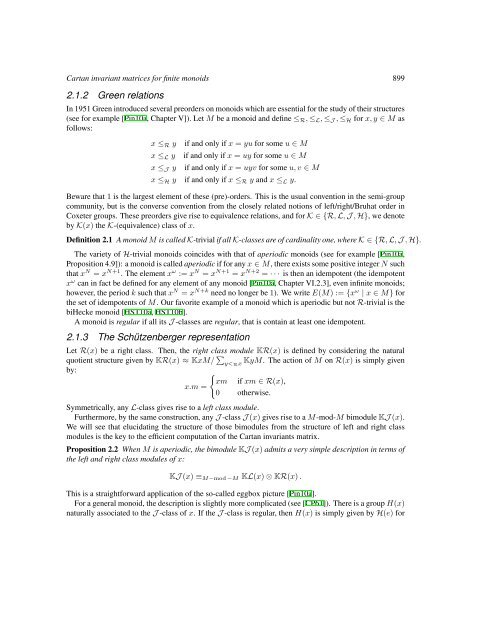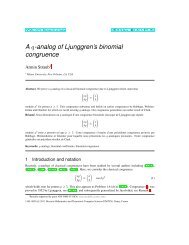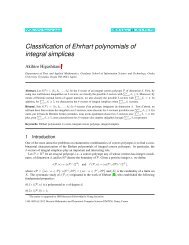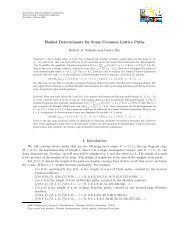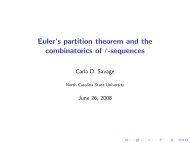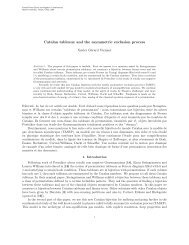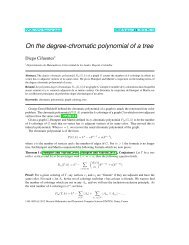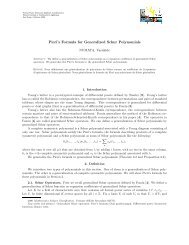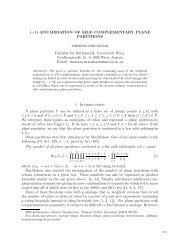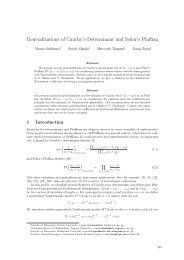Cartan invariant matrices for finite monoids - Nagoya University
Cartan invariant matrices for finite monoids - Nagoya University
Cartan invariant matrices for finite monoids - Nagoya University
You also want an ePaper? Increase the reach of your titles
YUMPU automatically turns print PDFs into web optimized ePapers that Google loves.
<strong>Cartan</strong> <strong>invariant</strong> <strong>matrices</strong> <strong>for</strong> <strong>finite</strong> <strong>monoids</strong> 899<br />
2.1.2 Green relations<br />
In 1951 Green introduced several preorders on <strong>monoids</strong> which are essential <strong>for</strong> the study of their structures<br />
(see <strong>for</strong> example [Pin10a, Chapter V]). Let M be a monoid and define ≤ R , ≤ L , ≤ J , ≤ H <strong>for</strong> x, y ∈ M as<br />
follows:<br />
x ≤ R y<br />
x ≤ L y<br />
x ≤ J y<br />
if and only if x = yu <strong>for</strong> some u ∈ M<br />
if and only if x = uy <strong>for</strong> some u ∈ M<br />
if and only if x = uyv <strong>for</strong> some u, v ∈ M<br />
x ≤ H y if and only if x ≤ R y and x ≤ L y.<br />
Beware that 1 is the largest element of these (pre)-orders. This is the usual convention in the semi-group<br />
community, but is the converse convention from the closely related notions of left/right/Bruhat order in<br />
Coxeter groups. These preorders give rise to equivalence relations, and <strong>for</strong> K ∈ {R, L, J , H}, we denote<br />
by K(x) the K-(equivalence) class of x.<br />
Definition 2.1 A monoid M is called K-trivial if all K-classes are of cardinality one, where K ∈ {R, L, J , H}.<br />
The variety of H-trivial <strong>monoids</strong> coincides with that of aperiodic <strong>monoids</strong> (see <strong>for</strong> example [Pin10a,<br />
Proposition 4.9]): a monoid is called aperiodic if <strong>for</strong> any x ∈ M, there exists some positive integer N such<br />
that x N = x N+1 . The element x ω := x N = x N+1 = x N+2 = · · · is then an idempotent (the idempotent<br />
x ω can in fact be defined <strong>for</strong> any element of any monoid [Pin10a, Chapter VI.2.3], even in<strong>finite</strong> <strong>monoids</strong>;<br />
however, the period k such that x N = x N+k need no longer be 1). We write E(M) := {x ω | x ∈ M} <strong>for</strong><br />
the set of idempotents of M. Our favorite example of a monoid which is aperiodic but not R-trivial is the<br />
biHecke monoid [HST10a, HST10b].<br />
A monoid is regular if all its J -classes are regular, that is contain at least one idempotent.<br />
2.1.3 The Schützenberger representation<br />
Let R(x) be a right class. Then, the right class module KR(x) is defined by considering the natural<br />
quotient structure given by KR(x) ≈ KxM/ ∑ y< R x<br />
KyM. The action of M on R(x) is simply given<br />
by:<br />
{<br />
xm if xm ∈ R(x),<br />
x.m =<br />
0 otherwise.<br />
Symmetrically, any L-class gives rise to a left class module.<br />
Furthermore, by the same construction, any J -class J (x) gives rise to a M-mod-M bimodule KJ (x).<br />
We will see that elucidating the structure of those bimodules from the structure of left and right class<br />
modules is the key to the efficient computation of the <strong>Cartan</strong> <strong>invariant</strong>s matrix.<br />
Proposition 2.2 When M is aperiodic, the bimodule KJ (x) admits a very simple description in terms of<br />
the left and right class modules of x:<br />
KJ (x) ≡ M−mod −M KL(x) ⊗ KR(x) .<br />
This is a straight<strong>for</strong>ward application of the so-called eggbox picture [Pin10a].<br />
For a general monoid, the description is slightly more complicated (see [CP61]). There is a group H(x)<br />
naturally associated to the J -class of x. If the J -class is regular, then H(x) is simply given by H(e) <strong>for</strong>


